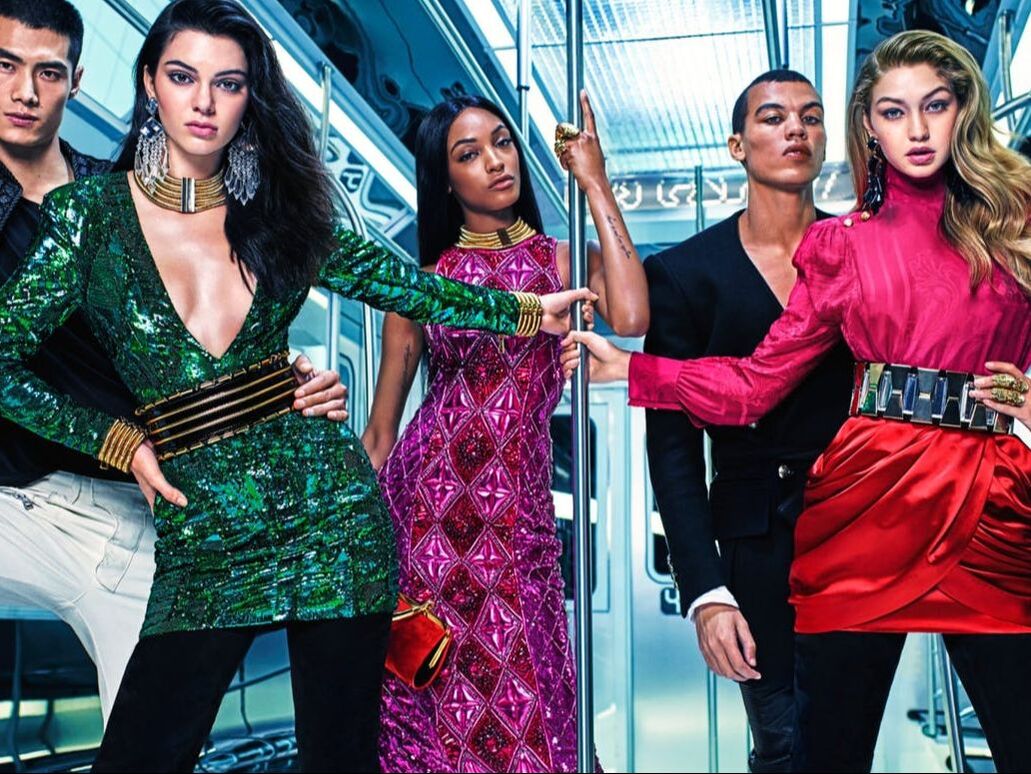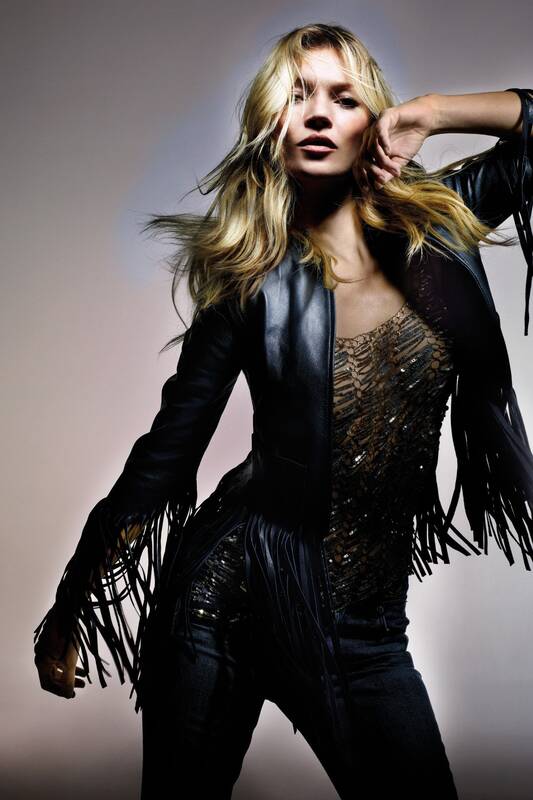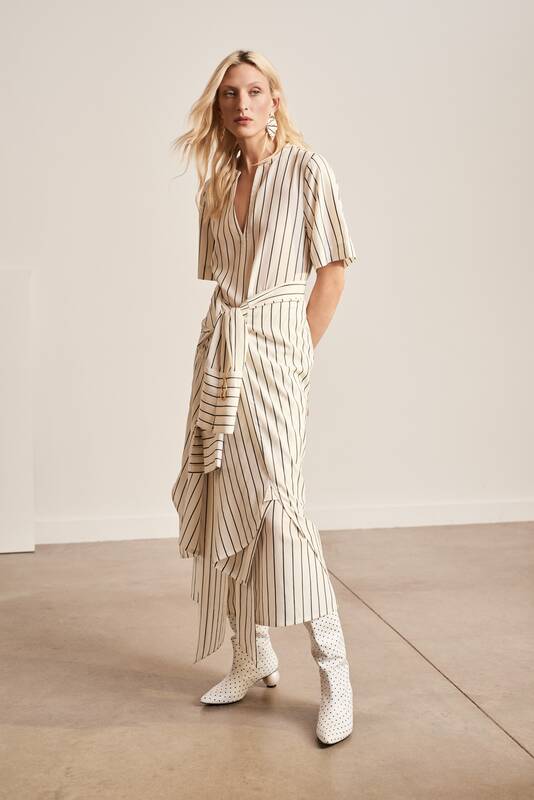|
As Gap announces a new partnership with both Yeezy and Balenciaga, we look back at the long, lucrative history of designer high street collections Yeezy Gap Engineered by Balenciaga may not exactly be the catchiest name for a collaborative collection (Balenciagap? Anyone?), but it is almost certainly the most buzzed about high street-designer collaboration for years. Call it the effects of the Covid-19 pandemic, call it a collective consciousness about the planet-destroying properties of fast fashion, but it’s been many years since fashion fans camped out overnight to be the first to shop the latest high-end H&M or Topshop collection. This isn’t for want of trying on the fashion industry's part. The demise of Topshop (RIP) undoubtedly dealt a blow to the phenomena but many high-street brands have continued to churn out designer collaborations in the past few years. They, of course, were also far from the originators of a trend that began many decades ago. Could YGEB be the start of a new Golden Age of high street collaborations? We chart their rise, fall and possible rise again… JCPenneyWhile it’s tempting to think of high street collaborations as a fairly recent phenomena spurred on by social media, the first true project of this kind was actually launched in 1983 – and it didn’t exactly received the rapturous praise that many designers received for similar ‘masstige’ lines now. In the early Eighties forward-thinking designer Halston teamed up with JCPenney to launch the lower priced Halston III line. While the collection itself was a huge hit, turning Halston into a household name, in the eyes of many upscale department stores this merely constituted a diluting of the label – proving to be the nail in a coffin built by the many licensing deals Halston was already involved in. After the collaboration, a number of elite stores, including Bergdorf Goodman, refused to carry Halston’s more expensive lines and, while the brand has struggled on to this day, it is but a shadow of its former self. DebenhamsWhile Halston and JCPenney gave it a good go, it was perhaps British department store Debenhams that was the first to make designer collaborations a real long-term success. Before Topshop and H&M came along with their flashy ad campaigns and hyped collection drops, Designers at Debenhams had been quietly giving shoppers access to clothing from high-end names since 1993. Unlike its successors, many of Debenhams’ designer collaborations formed part of its core, permanent range and could be shopped year-round. And, while Debenhams did have some big names on its books, most notably John Rocha (father of Simone), Richard Quinn, Preen, Roksanda Ilincic and Jonathan Saunders, its designer hook-ups tended to lack the same ambition and desirability, with its roster of designers also including Betty Jackson, Jasper Conran, Jeff Banks and Ben de Lisi. Catering to Debenhams slightly older demographic, collections were often less fashion forward and more aligned with the department store’s own-brand offering. H&MThe high street retailer beloved of everyone from teenagers to grandmothers stepped into the collaborations game in 2004 when it teamed up with Karl Lagerfeld, instantly setting itself apart via both the breadth of its collaborations, which often featured everything from accessories to ballgowns, as well as its price points. Unlike other collaborative efforts where the designer name still came with a small but noticeable mark-up, H&M’s designer collaborations rarely cost much more than similar garments from the retailer’s main line. A Jil Sander coat could set you back as little as £100 while a scarf or piece of jewellery often started from around £15 (unless, of course, you were forced to buy from the flippers on eBay – a common occurrence given the popularity of these collections). Often treating these collaborations as marketing exercises as much as profit opportunities, H&M also offered generous fees to its designers (reportedly $1 million each to Karl Lagerfeld and Stella McCartney in 2004/5 and a whopping $4 million to Madonna in 2007). Accordingly, many high-end designers were attracted by these lucrative opportunities and, over the last 17 years H&M has worked with labels including Comme des Garçons, Versace, Erdem, Alexander Wang, Balmain, Lanvin, Moschino and Isabel Marant. Even the famously publicity shy Maison Martin Margiela was tempted to bring its ultra-luxe Dutch aesthetic to the store in 2012. And, while they may no longer be the website-crashing, shoppers-camped-out-overnight on Oxford Street affairs they once were, the H&M designer collaboration is still going strong. In 2019 the brand worked with Giambattista Valli on a range of OTT evening gowns, collaborated with Simone Rocha, Toga and The Vampire’s Wife in 2021 and for 2022 has signed up fashion icon Iris Apfel to design a line. Yet, while these collections are undoubtedly successful – and now offer a far more pleasurable experience for shoppers who no longer have to worry about the anxiety of missing out on that must-have – we’re a long way from the sold-out-in-minutes Lagerfeld collection which saw H&M sales shoot up 24 per cent in 2004. TargetUS retail giant Target was also quick on the uptake, actually beating its UK counterparts to the punch when it launched its first collaborative line with Isaac Mizrahi in 2002. Notably, the collaboration was actually a comeback for Mizrahi, whose Chanel-owned brand, beloved of celebrities including Nicole Kidman, Sarah Jessica Parker and Natalie Portman, had shuttered in 1998. Sold under the tagline ‘luxury for women everywhere’, the Isaac Mizrahi at Target label made the designer a household name and proved incredibly fruitful, lasting for six years and eventually spanning fashion, accessories, bedding, housewares and pet products. Buoyed by this initial success, Target jumped into the designer collaborations scene feet first, enlisting houses including Phillip Lim, Tory Burch, Thakoon, Rodarte, Jason Wu, Peter Pilotto, Altuzarra, Missoni and Proenza Schouler. In 2013 it worked with 24 different designers, including Carolina Herrera and Diane von Furstenberg, in a single collection as part of its partnership with Neiman Marcus. Target didn’t restrict itself to fashion collaborations either. Product designer Michael Graves (the man behind the restoration of the Washington Monument) created homewares for the retailer during the Nineties while Joy Gryson, former director of design for Marc Jacobs handbags, offered up a capsule collection of bags starting from just $19.99 in 2008. By the time Target celebrated the 20th anniversary of its first collection with Michael Graves in 2019 by bringing back its greatest collaborative hits it had worked with 175 different designers. And it hasn’t finished riding the collaborations wave yet. It’s most recent designer partnership, for autumn 2021, saw it work with four New York-based designers: Victor Glemaud, Nili Lotan, Sandy Liang and Rachel Comey, while the season before it had been quick to snap up breakout design star Christopher John Rogers. We wait with bated breath to see who’s up next. TopshopDespite its huge influence on the genre, Topshop was relatively late to the collaborations game, dropping its first – not with a designer, but with international supermodel Kate Moss – in 2007. The partnership lasted for three years, with each collection selling out almost instantly, paving the way for many future collaborations. Unlike H&M, which tended to opt for established heavy hitters, Topshop’s preference was for home-grown rising stars, with collections by Christopher Kane, Marques Almeida, Ashish and Meadham Kirchoff all appearing in-store. The last collaboration, a disco-themed collection with Halpern, was released in 2018, the same year Arcadia Group owner Sir Phillip Green came under fire for sexual harassment accusations and Beyonce moved her Ivy Park label from Topshop to Adidas. Interestingly, Topshop was also one of the only retailers to take its high-low relationship in the other direction. Between 2005 and 2018, it was the only high street brand to show a collection, Unique, at London Fashion Week. The line, which offered pieces from £40 to £700, further blurred the boundaries between high street and high-end and ushered in an era of See Now Buy Now, with more than half the collection often available to buy immediately after the (live streamed) show. Perhaps recognising its considerable advantages over the small, independent labels that still make up the bulk of the LFW schedule, during this time Topshop also sponsored a show venue dedicated to presenting new design talent, which often became the hottest tickets of the season. UniqloRenowned for its well-crafted and thoughtfully designed, but somewhat utilitarian, staples, Japanese brand Uniqlo may not seem like the obvious partner for designers used to the exaggerations and dramatics of the catwalk. However, it is perhaps exactly this approach to accessibly priced clothing that has seen Uniqlo become the preferred retailer for some of high-fashion’s more intellectual houses. Getting into the collaborations game in the mid-Noughties, with ranges created in partnership with Opening Ceremony and 3.1 Philip Lim, it wasn’t until Uniqlo enlisted the talents of Jil Sander in 2009 that the fashion world really sat up and took notice. This was no limited capsule collection: ‘Chapter One’ of the +J range comprised of 150 pieces spanning men’s, women’s and accessories, all of which promptly sold out. Featuring the minimalist Jil Sander aesthetic, a cult following was assured and ‘Chapter Two’ quickly followed, along with a Best of +J line in 2014. After a seven year hiatus, the +J range was revived for a new AW20 collection of elegant cashmere coats and knits, crisp shirts and elevated everyday pieces designed to be worn again again. The success of the +J line also paved the way for a whole eco-system of quietly brilliant Uniqlo collaborations, including 2017’s team up with JW Anderson (which is still going strong today) and a new partnership with Theory which launched in 2021, as well as a constellation of niche brands including underwear specialist Mame Kurogouchi, outdoor performance label White Mountaineering and textile company Marimekko. Uniqlo has looked beyond the fashion industry for collaborative partners too. Since 2013 it has offered a thriving line of clothing and accessories created with French style icon Ines de la Fressange, while it also has a strong history of collaborating with new and established artists (and their estates), including Keith Haring, KAWS, Hokusai, Jean-Michel Basquiat and Jason Polan. John LewisOne of the most beloved department stores on the British high street, John Lewis has spent a lot of time and money developing its in-house fashion offering in recent years – but that hasn't stopped it showing its weight and importance by enlisting household name designers for one-off pieces and collaborations. Take, for example, the redesign of its Oxford Street flagship store in 2010. To mark the occasion John Lewis tasked designers, including Osman Yousefzada, Phillip Treacy, Alex Monroe, William Tempest and Terry de Havilland, with creating pieces for a special edition line of ready-to-wear and accessories. In 2020 the department store also looked to increase it green credentials with a line designed in partnership with Mother of Pearl creative director Amy Powney. The semi-formal line of slouchy suits, printed jumpsuits and shirts was made entirely from Tencel and organic cotton, with a second collection following in 2021. John Lewis’ in-house diffusion lines Kin and Modern Rarity have also provided fruitful ground for collaboration with smaller independent designers and artists, including London-based JJS LEE, cult Ibizan boutique La Galeria Elefante and Japanese manga creator Rie Takeda. GapProud member of a trio providing what’s likely to be 2022’s most hyped collaboration – Yeezy Gap engineered by Balenciaga – the high-street denim brand has found itself in a sweet spot of high-fashion relevance while also meeting the needs and wants of the masses at a time when it’s financial future was looking uncertain. Of course, as a global retailer that’s been around since the Sixties, this isn’t Gap’s first foray into high-low partnerships. Among the many notable partnerships in the store’s history is a five-year meeting of minds with shoe designer Pierre Hardy from 2007-11 and its 2007-9 Design Editions partnership with the CFDA/Vogue Fashion Fund, which saw designers including Thakoon, Rodarte, Alexander Wang and Phillip Lim reimagine Gap’s iconic white T-shirt and create limited edition capsule collections. There was also a brief but memorable children’s line from Stella McCartney that was so chic many adults, including Carla Bruni, happily admitted to buying it for themselves. As for what to expect from Yeezy Gap x Balenciaga? Well, to be quite honest, no-one is really sure. Ye’s 10-year deal with Gap was inked in 2020 and has so far yielded only a handful of hoodies and jackets while Demna Gvasalia’s Balenciaga has most recently been exhibiting runway collections comprised of oversized tailoring and ballgowns alongside red carpet face masks and collaborations with Crocs and The Simpsons. As ever in the wonderful world of fashion, it would seem that anything goes. |
Search by typing & pressing enter





















